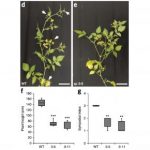What We’re Reading: October 5
 Guest editor: Magdalena Julkowska
Guest editor: Magdalena Julkowska
Magdalena is a PostDoc at King Abdullah University for Science and Technology (KAUST, Saudi Arabia) working with Prof. Mark Tester. Her main interests are (1) salt-induced changes in root-to-shoot ratio in Arabidopsis, (2) study the expression patterns in plants with enhanced sodium accumulation in their roots and (3) development of tools for data analysis based on R/Shiny. She is passionate about capturing plant architecture using simple models, understanding plant physiology and salinity tolerance.
Review – A plane choice: coordinating timing and orientation of cell division during plant development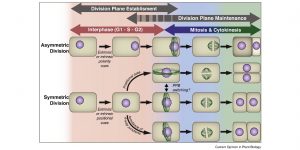
Asymmetric cell division is instrumental to development of specialized cells, while symmetric cell division underlies proliferative growth. The defects in cell division plane arise when transition between the G1 to S stage is accelerated, suggesting that the signals leading to division plane position are initiated in G1. Facette et al. summarizes the intrinsic and extrinsic factors controlling the positioning of the cell division plane. The internal signals include protein kinases like aurora and asymmetric protein degradation or modification. The environmental cues include mechanical stress affecting microtubule dynamics and positioning of the nucleus. Other external signals include peptides released by plant itself or a pathogen hoping to create its feeding site. The authors hope that future studies will increase our understanding how internal and external cues are integrated in division plate orientation in coordination of plant development. (Summary by Magdalena Julkowska) Curr. Opin. Plant Biol. 10.1016/j.pbi.2018.09.001
The Arabidopsis negative regulator of root hydraulics XND1 is involved in abiotic and biotic stress responses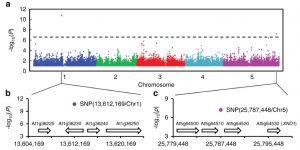
Proper uptake and management of water is essential for plant growth and adaptation to stress. However, there are gaps in the understanding of the genetics of root hydraulics, including the regulatory components. Tang et al. used a genome-wide associate analysis approach to identify XYLEM NAC DOMAIN 1 (XND1), a key negative regulator of Arabidopsis root hydraulics. XND1 modulates root hydraulic conductivity through xylem formation and possibly aquaporin function. Tang and colleagues describe natural XND1 variants that have distinct functionalities and they identify a single nucleotide polymorphism that describes XND1 translation efficiency and XND1‘s natural variation. Finally, XND1 is found to mediate the inhibition of xylem formation by the bacterial elicitor flagellin and play a role in resisting Ralstonia solanacearum infections. This paper describes a novel negative regulator of Arabidopsis root hydraulics that has a role in both abiotic and biotic stress responses. (Summary by Julia Miller) Nat. Commun. 10.1038/s41467-018-06430-8
Structural analysis of HTL and D14 proteins reveals the basis for ligand selectivity in Striga 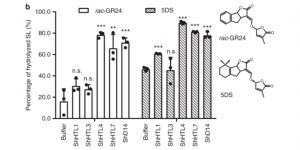
Strigolactones induce germination of parasitic plant Striga, which causes more crop loss in Africa than any other parasite. Karrakins are structurally related to strigolactones, yet they do not induce Striga germination. By studying the structure and substrate recognition of strigolactone and karrakin-binding proteins in Striga hermonthica, Zu et al. gained insight in high sensitivity of Striga to wide variety of strigolactones. The parasite specific clade of HYPOSENSITIVE TO LIGHT (HTL) bound to wide variety of strigolactones but not to karrakin. Compound binding pocket was larger in the pathogen specific HTLs, allowing for HTL to bind at low concentrations and recognize wide variety of hosts. The importance of pocket size for ligand recognition was verified using specific mutations. This study improves our understanding of strigolactone receptor evolution and provides new resources for the future methods to combat Striga. (Summary by Magdalena Julkowska) Nat. Commun. 10.1038/s41467-018-06452-2
Insights into the evolution of multicellularity from the sea lettuce genome ($)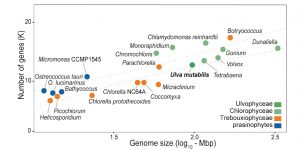
The transition from unicellular to multicellular life forms occurred across multiple kingdoms, and in plants is correlated with the expansion of gene families involved in extracellular matrix formation and cell cycle regulation. Green seaweeds acquired their plant-like body independently of other lineages and display wide form diversity. Sea lettuce, Ulva mutabilis, exhibits two morphological forms – flattened leaf-like structures or unicellular tubes – induced by the presence of bacterial communities. Ulva genome, sequenced by De Clerck et al., provides insight how the multicellular form arises possibly due to interaction with the environmental factors. Ulva genome is not only lacking genes typically involved in cell cycle entry and angiosperm-like hormone receptors, but has increased number of CONSTANS-like transcription factors and trans-membrane protein kinases linked to extracellular protein domains, which might be involved in integration of environmental signals. (Summary by Magdalena Julkowska) Curr. Biol. 10.1016/j.cub.2018.08.015
Members of the Arabidopsis FORKED1-LIKE gene family act to localize PIN1 in developing veins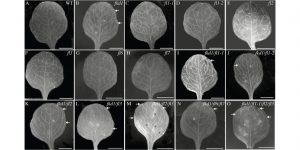
Vascular system is one of the adaptive features for terrestrial plants. Polar localization of PIN1 is essential for creating directional auxin flow, resulting in vein pattern formation. Mariyamma et al. propose that FORKED1 (FKD1) and its homologues control the PIN1 polar localization. The team identified eight FKD1-LIKE genes (FL1-8) in Arabidopsis, containing DUF828 and Pleckstrin homology/-like domains. The group-1 FLs were found in transgolgi network, while group 3 members localized to Golgi apparatus. Only the mutations in group 1 FL affected vein patterning through mislocalization of PIN1. Mutations in group 3 did not affect vein patterning, but resulted in larger leafs, suggesting that FL group 1 and group 3 coordinate vein patterning and leaf size. (Summary by Magdalena Julkowska) J Exp Bot. 10.1093/jxb/ery248
Rapid improvement of domestication traits in an orphan crop by genome editing ($) 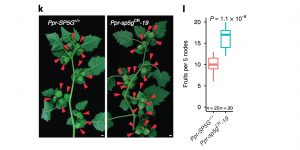
Orphan crops, like groundcherry (Physalis pruinosa), are regionally important but are not grown on large commercial scale as they never went through a breeding cycle. Precision gene editing techniques, such as CRISPR/Cas9, can alter the most important agronomic traits in relatively short time. Lemmon et al. targeted the Physalis orthologues of tomato self-pruning genes and CLAVATA peptide, using a tissue transformation protocol adapted from tomato. Targeting those domestication genes resulted in more compact plant architecture and increased yield due to higher number of fruit branches as well as larger fruit size. The success of similar approaches in other orphan crops, including teff, amaranth and cowpea, is likely to depend on the efficient transformation methods. (Summary by Magdalena Julkowska) Nat. Plants 10.1038/s41477-018-0259-x
Magazine Feature: Can botanic gardens save all plants? ($)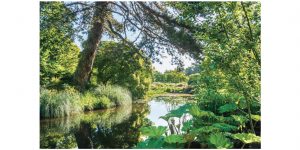
In the past botanic gardens served many purposes ranging from providing tranquil environment, spreading crops to places far away from their natural environment and providing emerging botanists with live samples. Currently, botanic gardens provide entertainment and education for millions of visitors. Can they also contribute to plant conservation? The location of botanic gardens is not exactly overlapping with the highest plant diversity, which is found in the tropics. While endangered species are often represented in botanical gardens, the preference seems to be given to large vascular plants, while smaller, non-vascular plants are often being overlooked. While botanical gardens in wide climate diversity might significantly contribute to ex situ plant conservation, it is no replacement for the maintenance efforts of the original habitat. (Summary by Magdalena Julkowska) Curr. Biol. 10.1016/j.cub.2018.09.010
Domestication of wild tomato is accelerated by genome editing ($) 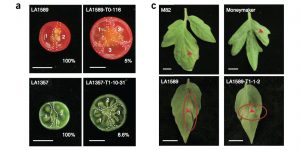
Wild tomato, Solanum pimpinellifolium, exhibits remarkable tolerance to salt stress and bacterial spot disease. Domestication of S.pimpinellifolium requires adjustment of day-length sensitivity, plant compactness, fruit size and the fruit could benefit from increased vitamin C content. Li et al. used multiplexed CRISPR-Cas9 strategy to edit genes previously described to affect desired phenotypes: SELF-PRUNING (SP), SP5G, CLEVATA3 (CLV3), WUSCHEL and SlGGP1. The transgenic plants exhibited compact plant architecture with intensive and synchronous fruit production and higher ascorbic acid content. The increase in fruit size was limited, possibly due to non-essential function of the targeted promoter region of CLV3. The transgenic plants retained their resistance to bacterial spot disease and performed better than the commercial lines under salt stress conditions. (Summary by Magdalena Julkowska) Nat. Biotech. 10.1038/nbt.4273
ABA-mediated regulation of stomatal density is OST1-independent 
Stomata are not only important for CO2 uptake, but are also important in limiting water loss when the water availability is running low. Stress hormone ABA activates protein kinase OPEN STOMATA 1 (OST1) leading to opening of ion channels, water efflux and stomatal closure. Increased levels of ABA decrease the stomata density in ABA over-accumulating mutant lines (cyp707a1/a3). By combining mutations in ABA sensitivity with defects in ABA biosynthesis or breakdown Jalakas et al. observed that ABA-deficiency leads to wider stomatal opening, while ABA overaccumulation has no effect on the aperture width. The ABA-sensitivity had no effect on the stomatal density, suggesting a separation of stomatal aperture regulation from stomatal development, which might be a useful tool in breeding programs. (Summary by Magdalena Julkowska) Plant Direct 10.1002/pld3.82
De novo domestication of wild tomato using genome editing ($)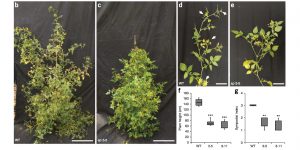
Breeding of crops typically focuses on yield increase, and is accompanied with the loss the genetic diversity, reduced nutritional value as well as susceptibility to environmental stress. As many domestication traits exhibit simple Mendelian inheritance patterns, Zsögön et al. targeted known domestication loci in wild tomato, Solanum pimpinellifolium, using CRISPR/Cas9 genome editing technology. Successful targeting of SELF-PRUNING (SP), OVATE (O), FRUIT-WEIGHT2.2 (FW2.2) and LYCOPENE CYCLASE (CycB), resulted compact plant architecture but no change in fruit size. The second round of experiments targeted genes related to fruit shape, number and nutritional quality FW2.2, CycB, CLAVATA3 and MULTIFLORA, resulting in fourfold increase in fruit number and 200% increase of fruit weight. No editing of off-target loci was detected in any of the transformed plants. As the domestication traits were characterized for other crops, including maize, wheat and sorghum, targeted reverse genetic engineering has potential to boost the development of new crops. (Summary by Magdalena Julkowska) Nat. Biotech. 10.1038/nbt.4272



